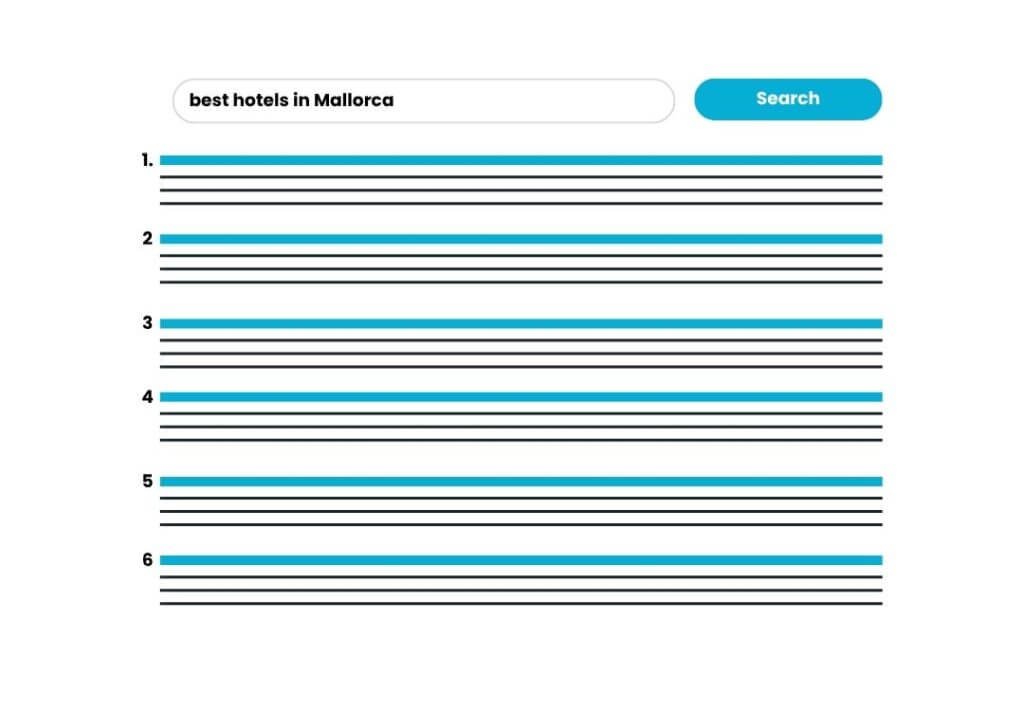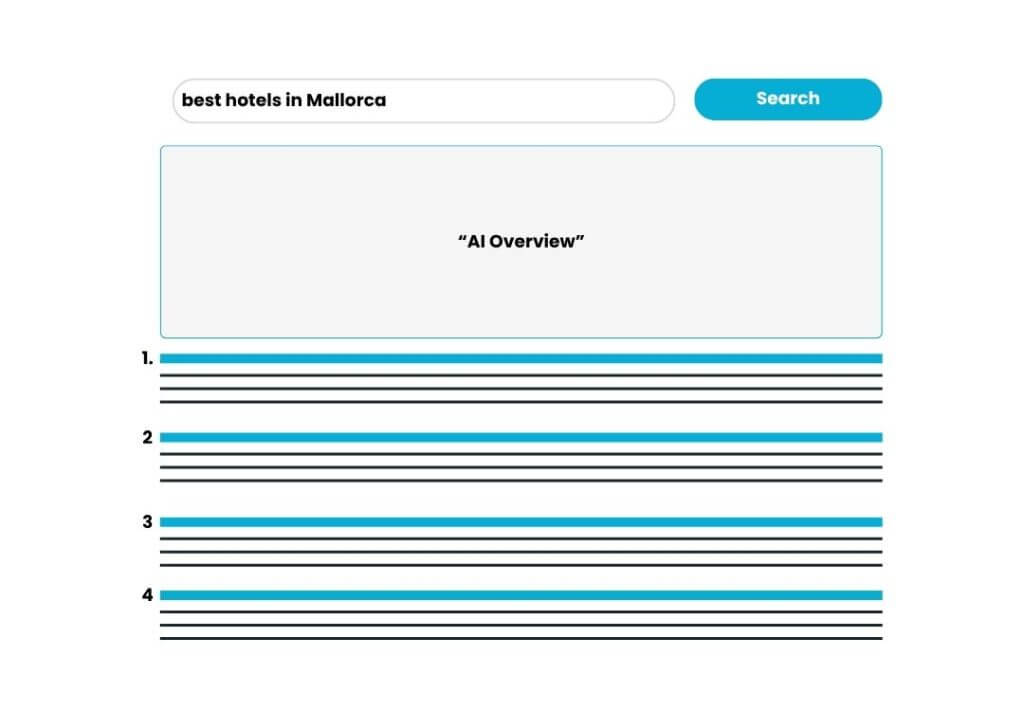Over the past few weeks, most Swiss websites have seen a significant drop in organic traffic.
This drop is correlated with Google’s introduction of a new feature called “AI Overview”.
To give a simple definition, artificial intelligence creates a summary of various sources found on the internet to respond to user queries on Google.
– Google’s “AI Overview” feature reduces organic traffic by providing direct answers to users’ queries
– The decline in SEO traffic is not related to a poor strategy but to a change in user behavior, utilizing various search channels.
– Traditional SEO is becoming insufficient and must be supplemented by an integrated visibility strategy, SEvO (Search Everywhere Optimization).
– Diversifying organic presence across multiple platforms, such as YouTube and social networks, is essential to maintain visibility.
Thus, users no longer need to click on site links because they receive their answers directly at the top of the search results.
We have observed a significant drop in SEO traffic for some of our clients whom we assist in their organic visibility digital strategy (SEvO).
It’s quite difficult to understand because, even though our clients have optimized their websites by implementing a solid SEO strategy, the problem mainly stems from a change made by Google.
Google has modified the way it displays results in its search engine.
it offers more and more direct answers, leading to a decrease in traffic to sites.

For many businesses, this decline in SEO traffic is not due to a poor strategy, but to the very change in the functioning of search engines.
Relying solely on SEO may no longer be sufficient.
This is where SEvO (Search Everywhere Optimization) comes into play, a more holistic and sustainable approach to remain visible where your prospects are actually searching for you.
Why your SEO traffic is really dropping (and it’s not your fault)
It is essential to understand why traffic is actually dropping.
We refer here to what could be called structural causes.
We are not talking about a website undergoing a design or content change but rather a visible erosion of traffic despite a good ranking.
This phenomenon is not due to poor SEO management; it mainly arises from the changing behaviors of users.
More and more people are using platforms other than Google, be it ChatGPT, Perplexity, Microsoft Copilot, YouTube, or even TikTok for their searches.
This fragments the query volume over a single channel.
Those using LLMs (Large Language Models) like ChatGPT no longer expect a list of links, as was the case with Google.
When they interact with a chatbot (ChatGPT, Perplexity, Copylot), they expect a direct answer to their question, which further reduces the need to send traffic to a website.
One might think there is little interest in AI assistants, as the generated traffic remains marginal on most websites.
However, this is not their primary function.
Google itself is also introducing its own chatbot (Gemini).
A new tab in the United States called “AI Mode” is being tested to offer users a conversational interface.
This means they can start a conversation through this tab by asking a question.
Then they receive an answer with suggestions or complementary questions to further the discussion.
This change in how Internet users search for information undeniably influences the share of traffic generated by traditional SEO.
Traditional SEO remains useful, but becomes insufficient if isolated
Strategies vary, but when we talk about an SEO strategy, it involves creating more content, investing in backlinks, and constantly optimizing content based on specific keywords.
This approach may seem justified, especially for established brands, but it remains limited.
Doubling investments in SEO is not a miracle recipe.
Indeed, content creation and link purchasing are costly.
However, one can continue to cover transactional inquiries (those where a user is specifically searching for a service or product) that are not yet affected by the AI overview and continue to generate traffic.
For example, a search for “Best hotels in Majorca.”

This is a query not yet covered by the AI Overview but requires quality content and above all, a good number of backlinks (links from other websites).
Nevertheless, it may soon be that these transactional queries are also covered by the AI Overview: Google offers a list of hotels without needing to visit a website.
It becomes clear that strategies must evolve.
Advising companies to maintain intense SEO efforts for optimal return on investment is becoming increasingly challenging.
The future lies in balance.
SEO must remain an acquisition channel, but it is imperative to diversify efforts to reduce dependency on a single, increasingly volatile method.
In the past, with a well-established strategy, SEO could generate 60-80% of a site’s traffic.
Today, things have changed, and believing that SEO is the only effective strategy will have negative consequences in the medium and long term.
Diversifying organic presence to reduce dependency on traditional SEO
Rather than investing exclusively in traditional SEO, it is crucial to explore the various opportunities offered by other channels.
Every platform with a search engine is an opportunity to appear organically.
For instance, YouTube is the second most used search engine. For brands or established companies, not having an active presence there is a tremendous-missed opportunity.
If the targeted audience is active on LinkedIn, Facebook, Instagram, or even TikTok, it is essential to optimize content for these networks.
To succeed, a 360-degree digital marketing strategy must be constructed to ensure more or less extensive visibility on all these platforms.
However, it should be remembered that this does not merely mean publishing irregularly.
Active presence requires engaging with the community by responding to comments as well as through relevant content that offers real value.
The concept of Search Everywhere Optimization (SEVO) is based on the idea of not limiting oneself to a single digital channel.
This also includes managing organic presence on channels such as local directories, news sites, and even specialized forums like Quora or Reddit.
Finally, don’t forget the GEO (Generative Engine Optimization) strategy.
It’s about appearing in Google’s AI overviews, but also in the responses generated by assistants like ChatGPT or Perplexity.
These LLM engines no longer just index site content: they also consider social media presence, directories, and other credible sources.
In the end, SEO and SEvO do not oppose each other but complement one another.
Structuring a more sustainable organic strategy
The decline in SEO traffic is not a disaster, but rather a sign of evolution.
It might be the perfect time to revise your strategy.
Adopting a SEvO (Search Everywhere Optimization) approach means stepping away from dependency on a single channel by combining multiple organic visibility levers.
This diversification allows for the targeted development of channels like LinkedIn, YouTube, or even AI assistants, in addition to traditional SEO.
The goal is not to mechanically compensate for every loss of SEO traffic, but to focus on the essential: where prospects are actually searching and how to convert them effectively.
This reflection lays the foundation for a sustainable visibility strategy.
If you wish to evolve your SEvO strategy, do not hesitate to contact us.
We would be delighted to help you define a concrete and structured action plan to strengthen your multichannel organic visibility sustainably.
Ready to talk about your digital strategy?
Your website is more than just a showcase. With SEO, it can become one of your strongest tools to win new clients.
I am an SEO consultant and digital marketing trainer with 20 years of experience supporting Swiss B2B SMEs.
My specialty is improving their online visibility through a “done with you” approach, which actively involves and trains their internal teams to achieve effective results.
Fluent in French, German (including Swiss German), and English, I adapt each strategy to the local market to effectively reach all regions of Switzerland.
From comprehensive technical audits to hands-on implementation—including keyword research and content creation—I guide my clients toward sustainable growth while respecting their company identity and values.
My mission is to share expertise so that every project becomes a true driver of long-term success.